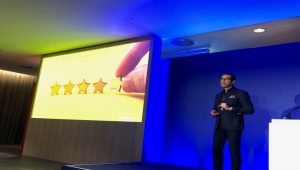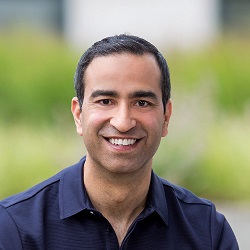
Gartner undertook a survey of 3,000 CIOs this year, in 89 countries across all sectors. Forty-nine percent of CIOs report their enterprises have already changed their business models or are in the process of changing them.
Brahmawar believes connected customer experiences will transform enterprises. New capabilities are needed to enable the connected experience and renovate enterprises. Capabilities such as direct customer relationships, IoT device management and subscription business. “Companies cannot become a connected enterprise by simply bolting digital initiatives into the existing infrastructure,” he says.
To become a truly connected enterprise, businesses must embrace all the key ingredients to succeed. This includes:
1 Becoming Hybrid
The landscape in most enterprises is changing. KPMG says that 44% of the enterprises are making the journey to the cloud. Organisations are learning to deal with sophisticated customer needs across distributed architectures to facilitate business success. They are also embracing hybrid infrastructures that combine traditional IT, private, managed and public clouds, to drive their enterprise.
2 Device Management

Businesses are collecting data and information and opening up their systems into a new level of connected environment. Most organisations now have an environment of sensors, devices, machine learning and systems all generating data.
Brahmawar advises data has to be managed to ensure the integrity of the supply chain or value chain. He suggests that device management and configuration is critical to the security of the data being collected. “As enterprises open their doors, there are multiple potential points of penetration. Cyber security remains paramount. It’s vital that IoT and sensor devices are effectively managed, as businesses move to be truly connected.”
3 Business Model
He notes that Software AG customers demanded that pricing, is more aligned to way they use the capabilities. They wanted these capabilities in a subscription format.
The company launched its new strategy earlier in the year, shifting away from perpetual licences to subscription. Consequently, 63% of all new bookings are now subscriptions-based contracts, more than double the rate of last year.
4 Pricing
Subscription potentially supports a more reliable cash flow. Businesses providing an everything-as-a-service enjoy annual recurring revenue. However, it also exposes enterprises to more short-term debt. Organisations have to change their internal accounting processes including billing mechanisms, data collection, debt management, payment planning and contract management.
Just as important is the internal cultural change that is required to support the transformation. As Brahmawar notes: “An aspect of faith is getting into a mode of being able to deliver service rather than just the product. The entire internal processes for organisation changes – the generation and collection of metering data, becoming important.“
5 Legislation
Organisations are increasingly collecting more customer data from sophisticated analytical tools and IoT sensors devices etc. As a result, all organisations are also gradually becoming custodians of customers data. This places a very important legal responsibility on understanding the various national and international legislation that governs the protection of privacy and personal data.
Enterprises have to be able to build legislation by design into all solutions. Brahmawar notes the EU’s GDPR as a great example. “It’s critical that we understand our organisation responsibilities. How to deal with data and how we manage the data and privacy aspects.”
6 Customer relationship
Businesses must open direct lines of communication with their customer. Customer expectations are high. If an enterprise effectively engages with its base, it totally understands the needs of its customers. It highlights potential pain points and identifies the relevant solutions. This directly structures conversations, so it is immediately relevant to the customer.
Increasingly, data is the lifeblood that sustains and nurtures customer relationships. Brahmawar observes traditional ways of managing data often create “tonnes of reports” for the business. He speculates that 80% of business reports are never used. For today’s enterprise, the most important challenge is to give access to the data directly to internal customer-facing teams. How fast and easily it can be converted into self-servicing analytics is critical.
7 Monetise data
Data has no value, if an organisation is unable to monetise its value. In a truly connected world of artificial intelligence, machine learning and IoT, enterprises must get focused on commoditisation. Brahmawar suggests businesses do not want to waste resources developing proof of concepts and user cases which go nowhere. Many of these activities fail to translate data streams into actual revenue streams.
Brahmawar says organisations have to be mobilised to understand and answer core questions. What issue or trend is being discovered? Is the organisation offering a new service with this data insight? What value can be developed with this insight? How can the business differentiate itself from its competitors?
Enterprise Times: What does this means for business?
Sanjay Brahmawar made a convincing and cohesive argument of the directions businesses need to adopt to stay relevant. The struggle to survive, in the age of disruption and competition, irrespective of size, sector, industry or geographical region. Over the years, organisations have readily adopted the mantra of digital or business transformation. This has often been translated as bolting on ‘customer experience’ or a ‘mobile first’ philosophy into existing infrastructure. Truly connected enterprises and innovators are incorporating the ‘connected experience’ across the entire fabric of the business.
However, one key area missing from Brahmawar’s approach, is the role of organisational cultural change in the transformation process. If you don’t have management buy-in, or don’t involve your employees, then the process will get lost in translation. This has to permeate from senior management to enable the enterprise to evolve into a connected enterprise.
Far too many organisations still pay lip service to the single customer view, regularly spouted in corporate literature. Data still remains in silos because of ‘old ways’ of processing information. These organisations are not even on the first rung of the ladder to become a connected enterprise. The danger remains, that they will be swept away by the tsunami of disruption.

























